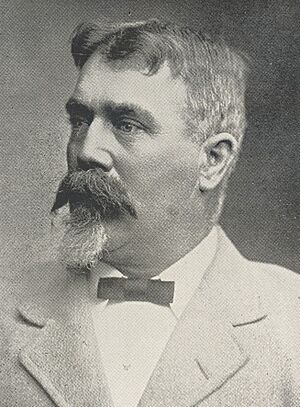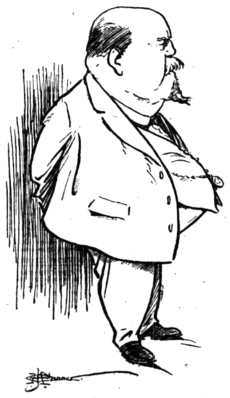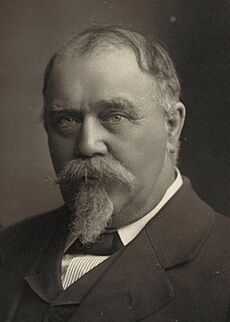John Verran facts for kids
Quick facts for kids
John Verran
|
|
|---|---|
 |
|
| 26th Premier of South Australia | |
| In office 3 June 1910 – 17 February 1912 |
|
| Monarch | George V |
| Governor | Sir Day Bosanquet |
| Preceded by | Archibald Peake |
| Succeeded by | Archibald Peake |
| Leader of the Opposition in South Australia | |
| In office 17 February 1912 – 26 July 1913 |
|
| Preceded by | Archibald Peake |
| Succeeded by | Crawford Vaughan |
| In office 5 June 1909 – 3 June 1910 |
|
| Preceded by | Richard Butler |
| Succeeded by | Archibald Peake |
| Leader of the United Labor Party | |
| In office 1909 – 26 July 1913 |
|
| Preceded by | Thomas Price |
| Succeeded by | Crawford Vaughan |
| Senator for South Australia | |
| In office 30 August 1927 – 16 November 1928 |
|
| Preceded by | Charles McHugh |
| Personal details | |
| Born | 9 July 1856 Gwennap, Cornwall, England |
| Died | 7 June 1932 (aged 75) Unley, South Australia, Australia |
| Political party | Labor (to 1917) National (1917–1918) Independent (1921) Liberal (1924) Nationalist (1927–1928) |
| Spouse |
Catherine Trembath
(m. 1880; died 1914) |
| Children | 8 |
John Verran (born 9 July 1856 – died 7 June 1932) was an Australian politician. He was also a leader in workers' unions. He served as the Premier of South Australia from 1910 to 1912. He was the second person from the Australian Labor Party (ALP) to hold this important job.
Verran was born in Cornwall, England. He came to Australia when he was a baby. He started working in copper mines in Moonta when he was very young. Later, he became the president of the local miners' union.
In 1901, he was elected to the South Australian House of Assembly. This was the state parliament. He was a member of the United Labor Party, which later became the ALP. Verran became the party's leader in 1909. This happened after the death of Thomas Price.
Verran's party won the state election in 1910. He became Premier. However, his plans were often stopped by the Legislative Council. This was another part of the parliament. His government lost the election in 1912. He stepped down as leader in 1913. He left the Labor Party after a big split in 1916. He then lost his seat in parliament in 1918.
After trying to get elected for other parties, he became a Senator in the Australian Parliament. This was from 1927 to 1928. He was a member of the Nationalist Party at that time.
Contents
Early Life and Work
Verran was born in Gwennap, Cornwall, England, on 9 July 1856. When he was only three months old, his family moved to Australia. They lived in Kapunda, South Australia until he was eight. Then, they moved to Moonta. Copper had been found there in 1861.
John Verran did not get much schooling. Before he was 10, he was already working in the copper mines. His job was to sort the ore above ground. This was called a pickey-boy. He went to night school some years later. Ministers from the Primitive Methodist church in Moonta helped him learn to read.
When he was 18, he went to the gold mines in Queensland. But he soon came back to Moonta. He worked as a miner there for almost 40 years. He was chosen as the president of the Moonta miners' union. He held this job from 1895 to 1913. Verran was also very active in his church. He was a local preacher for the Primitive Methodist church. He once said that his church helped him become a Member of Parliament.
Verran married Catherine Trembath in Moonta on 21 February 1880. They had eight children together. Catherine passed away in 1914.
Time in State Parliament
In 1901, John Verran was elected to the South Australian House of Assembly. This happened in a special election for the area of Wallaroo. He had tried to win this seat before in 1896 and 1899 but was not successful.
When Premier Thomas Price died in 1909, Verran became the leader of the Labor Party. The Labor Party wanted Verran to become Premier. However, the leader of another party, Archibald Peake, refused. So, Peake formed a government that lasted for one year.
The next year, Verran led the Labor Party to a big win in the 1910 election. They won enough seats to form South Australia's first majority government in the House of Assembly. This happened less than two weeks before the Labor Party also formed Australia's first elected federal majority government.
On 3 June 1910, Verran became Premier. He was also in charge of public works, mines, and water supply. His government lasted for less than two years. During this time, there were protests in Adelaide because of a drivers' strike. People also criticized how Verran handled this problem.
His government spent a lot of money on railways and harbors. A new law in 1911 helped poorer people get loans for homes. But the Legislative Council did not support his plans to create state-owned brickyards and timber mills. There were many disagreements between the two parts of parliament. Verran even asked the British parliament to overrule the Council's decisions.
Verran called an election in 1912 to try and change the power of the upper house. However, the Labor Party lost votes. They ended up with fewer seats.
As a regular member of parliament during World War I, Verran was part of a group that held strong views. He supported a campaign against people of German background. He wanted to close all Lutheran schools. He also wanted to remove voting rights from people of German origin. He believed that German children should be taught only English by British teachers. These views were common at the time but are not accepted today.
Verran was replaced as Labor Party leader by Crawford Vaughan in 1913. Verran left the party in 1917 because of disagreements about sending Australians to fight in World War I. In 1918, he ran for election as a member of the National Party but lost. He also tried to get elected as an independent in 1921 and as a Liberal in 1924, but he was not successful.
Time in Federal Parliament
Verran tried to become a Senator in the Australian Parliament in 1922 but did not win. He also tried to win a seat in the House of Representatives in 1925.
On 30 August 1927, when he was 71 years old, Verran was chosen by the state parliament to fill a vacant Senate seat. This seat became empty after Senator Charles McHugh passed away. After he joined the Senate, Verran often spoke about worker relations and how different levels of government worked together.
He supported changes to laws about workers' disputes. He also wanted secret votes to decide if workers should go on strike. Even though he came from a union background, Verran started to speak more against unions. He said that some union leaders were causing many problems. He also described unions as "political fighting machines."
Verran also supported a financial agreement between the federal government and the states. But he said he had "never been a federalist." He even fought against the idea of federation when it was first proposed. He believed it would harm the country.
Verran lost his Senate seat in the 1928 election. He had served for just over a year.
Later Life
John Verran's wife passed away before him. He was survived by three sons and four daughters. He died at his daughter's home in Unley. He was given a special state funeral. He was buried in Moonta.
John Verran was known as an honest person. For many years, he was a powerful figure in the Labor Party. But his political career mostly ended when he left the party.
See also
- Verran Ministry
- Hundred of Verran



